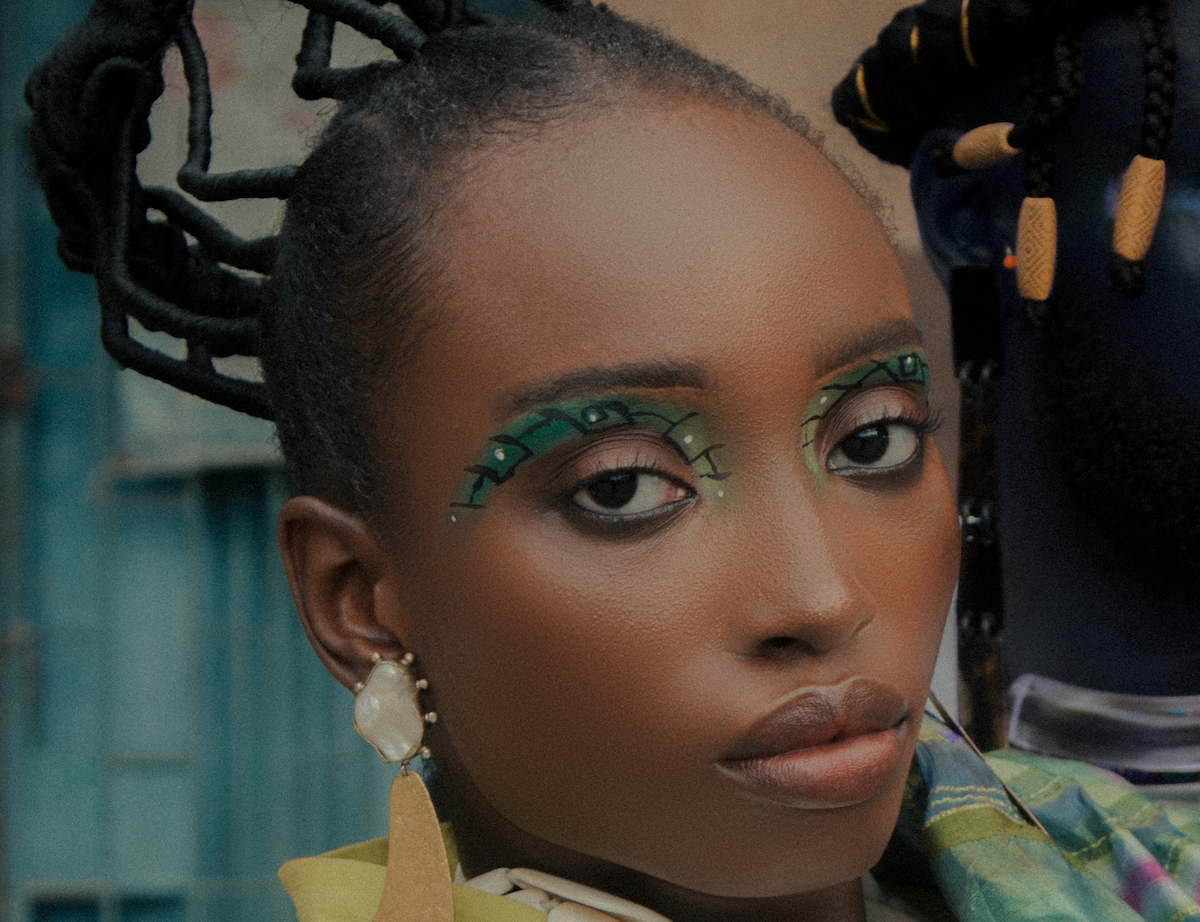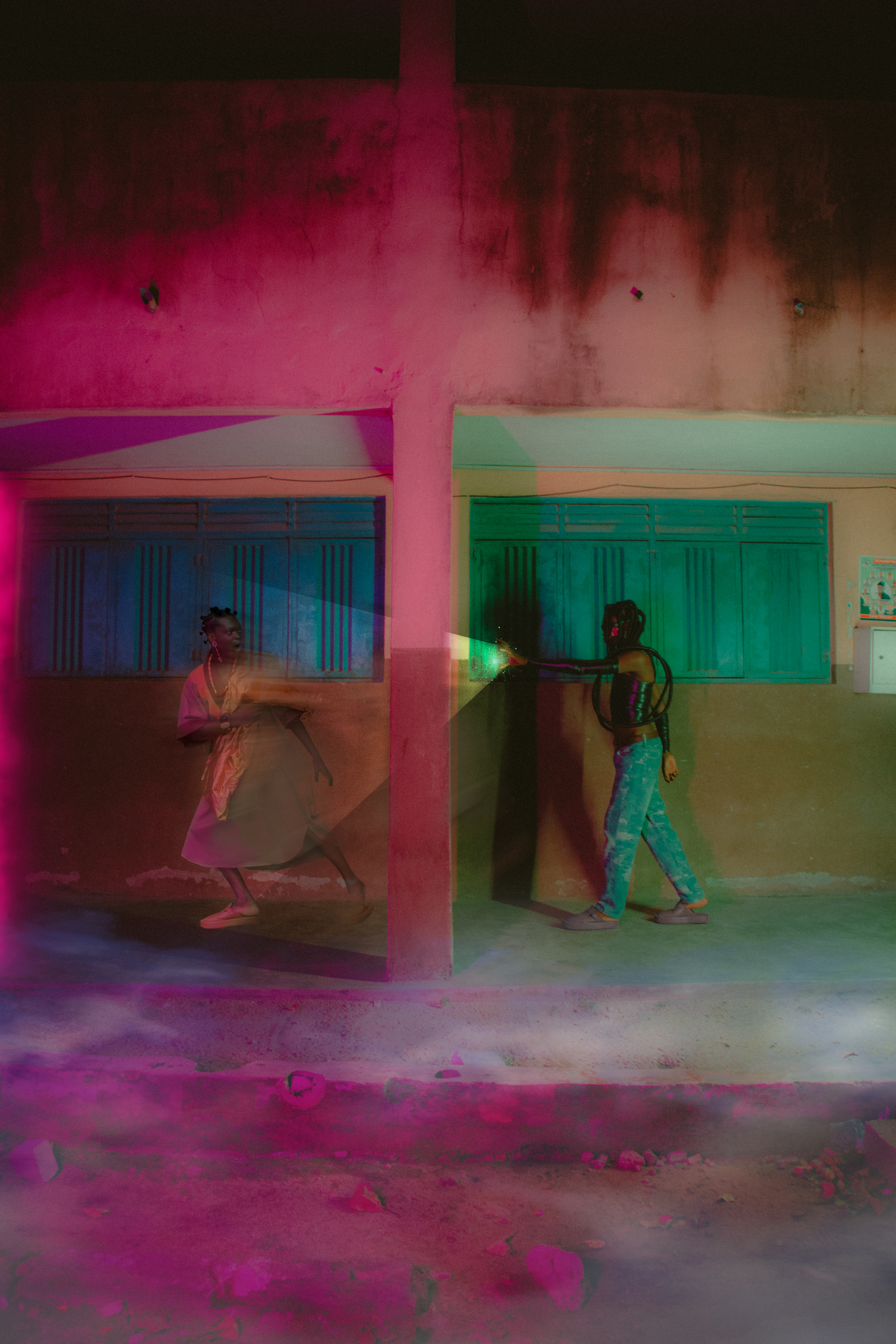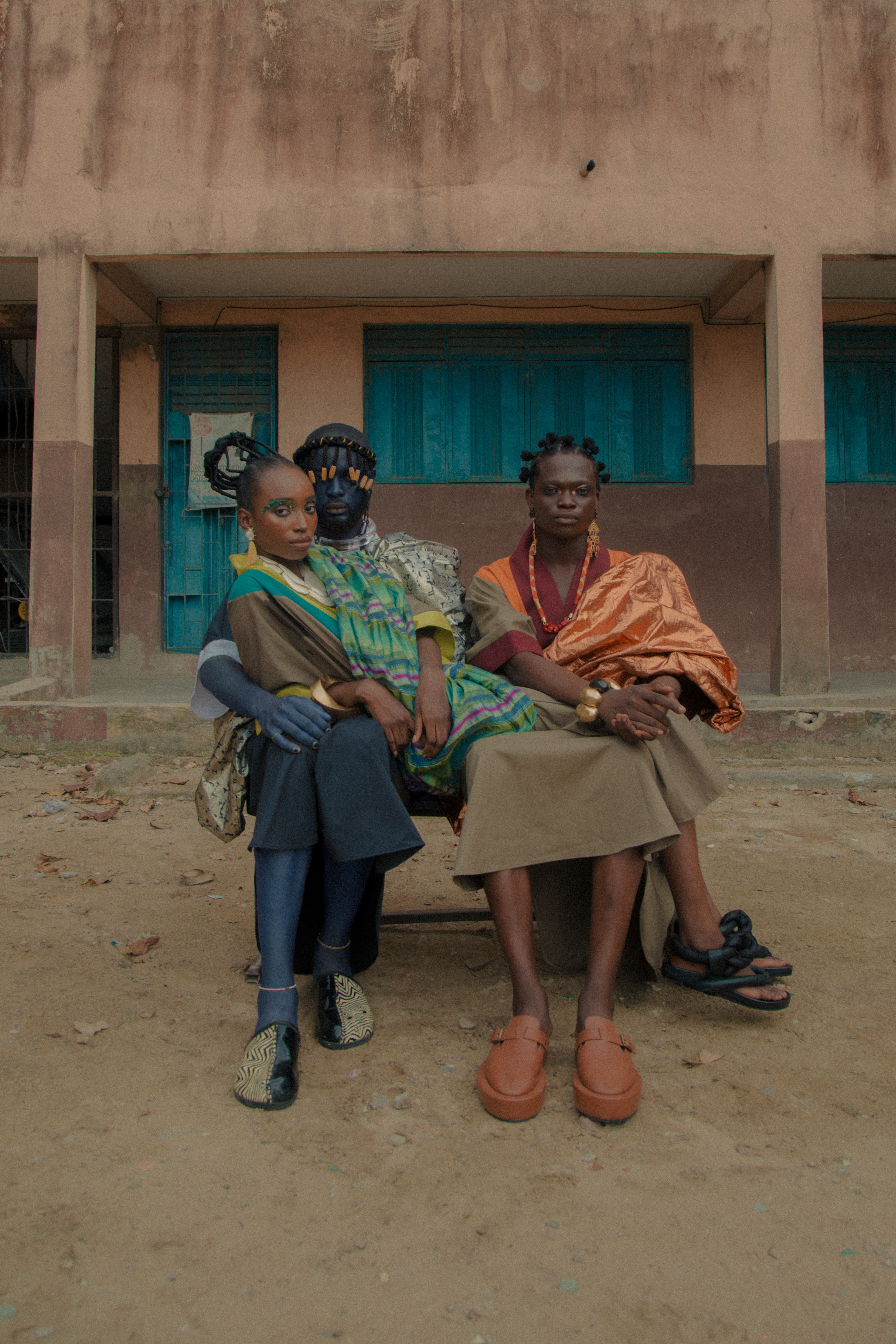
Afrotopia: Looking at Afrofuturism in Fashion
This roundtable is excerpted from Nataal Issue 3 in partnership with Africa Fashion, on view at the Brooklyn Museum June 23–October 22, 2023.
“Afrotopia is an active utopia that takes as its task the cultivation of vast and open spaces of bountiful possibles in order to help them flourish. The challenge thus resides in articulating a thought that bears on the fate of the African continent… by identifying the site where new practices and discourses have already begun to express themselves, where this future Africa can come into view.”
Felwine Sarr’s meditations in Afrotopia—the landmark book by the Senegalese economist and philosopher—proved to be an inspiring starting point for Dr. Christine Checinksa to explore how African designers and creatives are imagining the future. Africa Fashion is not concerned with Afrofuturist visions of rocketing into outer space. Rather, it’s about rediscovering the continent’s pre-colonial histories, mythologies, cultural and spiritual traditions in order to heal and reach beyond traumas of the more recent past, and ultimately to create a future in which Africa is centred, self-actualized and free.
Senegalese fashion designer and filmmaker Selly Raby Kane, British-Ghanaian author and curator Ekow Eshun, and Kenyan creative director and stylist Sunny Dolat have devoted their practices to this work. Dr. Checinksa believes they are already “shifting the geographies of fashion.” We brought them together for a roundtable, during which they discussed their ideas of Afrotopia through a fashion lens.
Accompanying their conversation is a visual odyssey by Nigerian photographer Ruby Okoro entitled First Three: A Visit From Time.
A Shifting of Gaze
Ekow Eshun: You know, we’re all in different countries, on different continents. And from my position here in Britain, sitting at the historic heart of Empire, it’s an uncomfortable place to be in all sorts of ways. I think of the 1950s, which was the start of mass immigration to Britain—chiefly from the Caribbean, but also from the Commonwealth, so parts of Africa as well—and the many people that came off the ships were actively critiqued on the basis of the cut and color of their clothes. These clothes were regarded as too flamboyant, too somehow “unserious” for a British mentality. And it's a clash from the 1950s onwards, about whether the wearing of bright clothes—say, a woman in a red dress, a man in a purple zoot suit—in a way disallows or excludes African or Caribbean people from being truly British.
“We can think into the fantastic, into the magical, and for that not to be an escape, but for that to be deepening our exploration of how we live and of who we are.”
Sunny Dolat: Kenya was a settler colony, and so the British strategy here and in, for instance, Nigeria was completely different. The way the British colonized us was culturally, and one of the places that you see that very clearly is in dress. I would say that Kenyans are among the most conservative dressers on the continent, even just in terms of color when you're walking through Nairobi. We gravitate toward navy and grays and whites and black, and we drink tea at 4 pm, you know? You want to look good, but you don't want to look too good. There's always this idea of, like, if you're dressing up, you're dressing up for someone or for something, it's never quite for yourself. Whereas when you look around at the countries that either were not colonized by the British, or the British had a different strategy, you see such a wealth and such a pride around dress.
Selly Raby Kane: As a Senegalese brand wanting to be sold throughout the world, you have an expectation of what your creations should be, of what the textile you use should be, of your silhouettes—what you are and what you are supposed to create as a human being is predefined and preconceived in the gaze of the people that are concerned. I think all of that might be quite heavy for a creative in any country in the world. Those are the things that need to be set aside.

Photography by Ruby Okoro (full credit below).
EE: I'm completely nodding when you say that. I mean, ultimately you have to try and see beyond it, or reach beyond it. If I look at your work—to make fashion, to make films, to create a way of presenting and a way of seeing that reaches beyond the kind of presentations that come from the West—I think about a sort of shifting of gaze. And crucially, I think the process of decolonization is a kind of process of imagination; it’s not that one is dismantling an economic system, but it’s about saying, “To see ourselves, we have to imagine ourselves outside this given template.” We have to imagine ourselves anew.
Looking Beyond Afrofuturism
SRK: I have to say I’m struggling a bit with Afrofuturism lately. The first time that I came across works of Afrofuturism was around 2012, and I felt like I found a family and an aesthetic. But the more I went through them, the more I felt like I was witnessing some type of impossibility. The juxtaposition of Black bodies and Western technology, and not seeing enough Black people creating the technology, that was very difficult for me.
Also, there’s a really interesting approach to time that I found here in Senegal. I started to read on immaterial heritage and on esotericism and I realized that in my culture, people didn't approach time as a linear thing. It was something that was fractals of loops, and each loop could access the other; rather than backwards or forwards, there was access to all those capsules of time. Once I understood that, the notion of “the future” became rigid. There's something beyond Afrofuturism that is happening here. Many other creatives that were in the Afrofuturistic movement in Senegal are today feeling a bit constricted by the label. I feel like there's something else.

Photography by Ruby Okoro (full credit below).
SD: Yeah. I worry that Afrofuturism is heavily influenced by the Global North, that our explorations and even framework of Afrofuturism are still pegged on the Global North’s aspirations for the future. For instance, it's completely understandable that one kind of futurism would be around Africans in space, but I wonder if that's because of all the movies that you see of, like, Americans and Russians going to space. Sometimes I wonder if Africans actually do want to go to space.
EE: What’s happened with that term “Afrofuturism” is it's kind of devolved into clichés: pyramids, flying saucers, Sun Ra. It’s all fun, but also, it's kind of slightly problematic. Essentially, look: part of it is actually predicated on an idea of African under-development. So, the notion of this sort of shock of Black people and technology is supposed to be a juxtaposition rather than a symmetry, and that’s part of the problem.
SD: I think one of the things that would be useful for Afrofuturism is absolute freedom to decide and determine what it wants to be and what it wants to do, without having to align itself to any sort of other future ambitions from anywhere else in the world. And if the idea of Afrofuturism is this return to land and complete abandonment of technology, then so be it. And that makes complete sense.
EE: That's why I've been playing with a term like the “Black Fantastic” as a more capacious, more open territory, which allows us to think back in time, as well as into the future. It's not really about the relationship to technology per se; it's about how we have always had to think about our place in the world, had to invent and keep reinventing our place in the world, and about how, as a consequence, we're allowed to draw on these histories and heritages, these belief systems that can go way back in time.
These, it turns out, are still radical positions. As you say, they allow us to think about time not as linear. And why that is important is because again, you look from a Western perspective, the notion of historical development always places Africa as either outside that history, outside the trajectory of development and progress and future, or else, at its very base. Africa is always the beginning point. You always have to leave Africa to get to the future, you know?

Left to right: Francis wears Turfah robe and scarf from Alara, Monies earrings and choker from Alara, own shoes. Ewaoluwa wears Turfah robe and scarf from Alara, Peet Dullaert earrings from Alara, Monies necklace and bangle from Alara, Pichulik necklace from Alara, George Lamondelli bangle from Alara, Zanger shoes. Ayorinde wears Turfah robe and scarf from Alara, Mercedes Salazar earrings from Alara, Monies bracelet from Alara, Kkerele shoes. Photography by Ruby Okoro (full credit below).
But, as we know otherwise, so much of African culture is about thinking about the future as a circular territory that can be visited in a number of different ways. And to put it grandly, I think part of our search for liberation has to be beyond some of these linearities, some of these historical constrictions. And Afrofuturism, for all of its imagistic possibilities, at least partly fits into this trope. The concept can’t hold the depth and the breadth of creative imagination that we see playing out within Africa and or in the African diaspora. Things are much more inspiring than some of that concept now allows for.
SRK: Exactly. It’s very interesting. And, you know, not every African that thinks about the future in their creative practice is an Afrofuturist.
EE: We have to think deeper than that. We have to think about cultural heritages and what we have to draw from as a way to build into the future. Because again, I feel like we've often been taught that these cultural practices or spiritual beliefs are somehow primitive.
SRK: We have been taught that [laughs].
EE: But, you know, I would suggest one aspect of our shared heritage is the ability to be able to wander, to able to find and locate, and bring together. And in that respect, looking back in time is a wholly legitimate way of thinking further about how we build a future, how we walk into a future. In a way, not to do that is the strange thing. The idea somehow that that's a disqualifying practice, that's the thing to be skeptical of.
Back to the (Pre-Colonial) Future
SD: I hope that the metaverse allows people to engage with African fashion beyond just looking at it. Perhaps that'll be the next way for African designers to start to get their work seen, and to skip the nonsense of logistics, so that you're able to buy, like, metaverse Orange Culture and wear it on your metaverse body.
But I'm still here with textiles [laughs]. Kenya doesn't have a strong textile history, unlike other parts of the continent. The shuka was introduced to the Masai by Scottish missionaries, which is why it looks so much like tartan. And then we also have kikoi, which is based on an Omani textile, and kanga, which is based on a Portuguese textile. And while these textiles are widely used and loved throughout the country, I think there's also a curiosity around indigenous textile heritage, because you know, the colonialists sabotaged any kind of local manufacturing that was happening.
I'm interested in at what point heritage is established. Just because it’s 2022, does that mean that it's not possible to establish a textile heritage? For me, a large part of the future—a lot of my work and thoughts and experiments around textile development—is actually in looking back. The making processes in Kenya were inherently sustainable. All the dyes and materials were organic and most importantly, there's always been this very deep, respectful relationship with nature, where people knew just how much to take. Their relationship with the land was so clear.
SRK: I see as well a true return to the systems of ancestral beliefs, to the myths, to the healing approaches—a return to studying those and to make them tools to build the future, or to build today and, you know, just speculate on what tomorrow might be. If we have some type of conversation of what used to be, it makes a firm basis for how we want to live today and how we want to project ourselves.
.jpg)
Left to right: Francis wears Delirious Communion top, own trousers and shoes. Ewaoluwa wears Delirious Communion top, own skirt, Zanger shoes. Ayorinde wears Delirious Communion top, own trousers, Kkerele shoes. Photography by Ruby Okoro (full credit below).
Reading Amadou Hampâté Bâ has been fundamental for me, and the Peul Fulani mythology on the creation of the universe. And I’m fascinated by talismanic writing for healing and protection—where the spoken word and the written word become active and have an effect on the body and how it moves within its environment. It has been my obsession for quite a bit of time now.
I see many creatives here in Dakar—fashion designers, shoemakers, comic book illustrators—operating some type of return to have the tools to heal, to face the world. And I think there’s a realization of the equal dignity of all of the archives of this world, and all the means to heal.
SD: I'm very interested in this space in which spirituality and fashion intersect. I've been interested in the land and the sea as living, breathing entities. Again, it’s such a historical thing—if you look at many African cultures, there’s equal parts fear and admiration of the ocean, and similarly with the land. I've been negotiating my interaction with both of them, and just curious about the power that lies in them. And so, I created a ritual textile, hand-woven from cotton and silk, stained by being buried in the earth over a couple of days. Looking at the textile, what you're really looking at is an imprint, a memory of the land.
I've also been thinking about talismans, and clothing and jewelry as protection. I found this phenomenal cloak from Niger that had all of these talismans sewn onto it. I’m still so bummed that I didn’t get it—it was a bit scary looking [laughs]. But what it reminded me of is that in many parts of the continent, there's deep intention attached to items like this—everything has meaning.
If you look at Kenya, we might not have a deep textile heritage, but what we do have is a phenomenal heritage of adornment. And so, the thing that Kenyans completely understand is jewelry. There is something called a hirizi that you find in the coast—it’s a sort of locket, which is hollow on the inside, and usually it contains a scroll, like a prayer or a verse from the Koran, that you're able to slide out. Creatively, I'm interested in that ability to contain something.
I've been wondering if there's a way to explore talismans for this day and age. I was speaking to a couple of friends and it was funny because what came out of that conversation was that phones appear to be our modern-day talismans, which, when you think about it, yeah they are, not for what it represents, but for what it holds. I think in the future, anything could be a talisman.
.jpg)
Photography by Ruby Okoro (full credit below).
EE: I've been curating an exhibition at the Hayward Gallery called In the Black Fantastic (29 June–18 September, 2022), and it’s about works with visual artists, but it’s exactly about this realm of the possible, this realm of new dreaming, and new thinking about how Blackness, and an interrogation of Blackness, opens us up to these deep histories, elements of spiritual practice, but also these interpretations or imaginations of potential futures. And for me, this territory is part of a kind of contemporary lingua franca, at the moment, for Black creatives. It’s this thing of reaching beyond and challenging the quotidian and the ordinary and the apparently real.
This comes back to these set expectations that come out of a colonial system, about how we should be, how we should conduct ourselves, what we should wear. Partly this is about saying, we don't need to be constrained in those terms, at all. We can think into the fantastic, into the magical, and for that not to be an escape, but for that to be deepening our exploration of how we live and of who we are.
Excerpted from Nataal Issue 3 in partnership with Africa Fashion. Buy a copy of the magazine here. Image credit: Photography by Ruby Okoro. Styling by Abigail Oghene, Yosa Nosa, Hair Braiders Club. Make-up Edima Willie. Models Francis Emmanuel, Ayorinde Olabamiji, Ewaoluwa Onilenla. Production Olachukwu Offor. Lighting and assistance Okoli Isaac.
Christine Ajudua is a US journalist and editor telling stories across style, travel, food, art and culture. Her work has been featured in Artnet, Condé Nast Traveler, New York Magazine, The New York Times, and The Wall Street Journal.
Ruby Okoro is a Nigerian visual artist creating images that take inspiration from everyday Nigerian life and transforming it into hyper real scenes steeped in spirituality and rich colors. This work is entitled “First Three: A Visit From Time.”